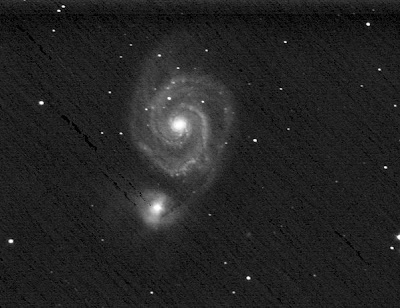9pm-12am
A truly clear night, almost warm. The moon, however, is high in the sky and three quarters full, its brilliance nearly drowning out the fainter DSO's. In a few days, it will be full and I will need to wait until it wanes before resume imaging sessions.
The scope was first polar aligned – but not too well, I'm afraid – using Polaris and Arcturus, and the realigned using Arcturus and Regalus. The tracking was okay, and delivered object to the FOV most of the time in GOTO, but I could only expose for 15 seconds before getting movement in the image.
M65
With the bright moon so close by, this galaxy was almost lost in the glare.

M97
I continue to try and capture the Owl, but 15 second sub-exposures just aren't cutting it – and the bright moon didn't make it any easier.
M99
For once, a decent image.
Compared to the image I took a couple of weeks back, this stack of 100, 15-second sub-exposures shows an incredible amount of detail in the spiral arms – despite the moon's interference. The difference between this photo and the previous one is a much finer focus.
M91
Discovered by Charles Messier in 1781, M91 is a barred-spiral galaxy. While it possesses a relatively bright core, the spiral arms and the “bar” connecting them are quite faint and difficult to record.
M104
I always wait too long before getting around to the Sombrero. By the time I swung the scope toward Virgo, this galaxy was already headed for occlusion by the treeline. So I didn't have enough time to image it properly – as usual.
Still, the central dust lane is remarkably visible. The trick will be to capture detail within the dust lane itself. In order to do that I will need to increase the magnification. This photo, like all the others, is taken with the LXD75 at f/5. Barlow lenses would increase the f-ratio to f/10, but I don't know how well that would work with the DSI.
M13
The largest and brightest globular cluster in the northern sky.
This is almost certainly the best image I have ever obtained of M13 and shows just what the DSI Pro is capable of – if it has a good focus.
M13 was first discovered by Edmund Halley – the discoverer of Halley's Comet – in 1714 and was added to Messier's catalog in 1764. It is thought to have a diameter of about 145 light years, into which are squeezed several hundred thousand stars. Astronomers place its distance from Earth at about 25,100 light years.
















